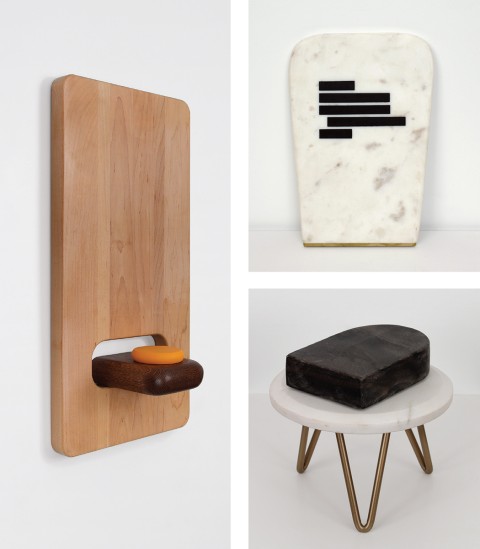Steve Novick’s (clockwise from left) The Pill; Epitaph; Cemetery Table

Images used by permission of the artist
Steve Novick’s work balances delicately on the seesaw of paradox. It is subversive but reverent, iconic but mundane, simple but complex. To me, these tensions make him an acute commentator on religious rituals and language.
In The Pill (2024), Novick deploys a cutting board to suggest a face, tongue extended to receive a puck of medicine or perhaps the eucharistic host. Three slabs of found wood are sufficient to pose probing questions. Is communion a form of placebo or does it offer a spiritual panacea? Who has placed this wafer on the tongue? Has the viewer become the priest, sacralizing the gallery experience, or are we invited to take this mysterious pill from the artist?
Many of Novick’s recent works meditate on death and memory, inducing appreciative smirks that ripen into philosophical quandaries. In Epitaph (2022), a marble slab has a few bars of black rubber pasted across its surface, suggesting the black mark of a redactor’s pen. This censorious touch suggests the despotic reach of autocracy, effacing identity even unto death. But the work is no prisoner to our present political moment. It also reminds us that however pridefully specific our lives may appear, the details are—in the grander scheme—inconsequential, fading to black.
With another piece of found marble, Novick continues these ruminations on mortality. In Cemetery Table (2024), rather than standing upright, a tiny headstone lies supine on a miniature coffee table. Stone turns to flesh, suggesting an examination table or embalming station, recalling Rembrandt’s The Anatomy Lesson of Dr. Nicolaes Tulp (1632) or Mantegna’s Dead Christ (c. 1480). On the one hand, Novick reveals the bald face of consumerism, in which even mortuary or memorial rites can become luxury objects. But he also taps into a long tradition of meditating on the inevitability of death, from the memento mori in Western art to depictions of corpse meditation in Buddhist art. Perhaps placing a reminder of death in one’s living room is not insulting to the dead but a corrective for the living.




